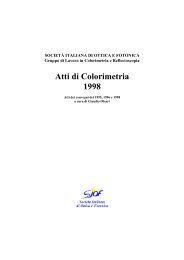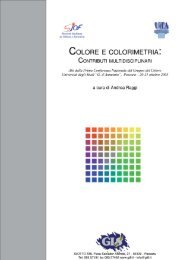Scarica gli atti - Gruppo del Colore
Scarica gli atti - Gruppo del Colore
Scarica gli atti - Gruppo del Colore
You also want an ePaper? Increase the reach of your titles
YUMPU automatically turns print PDFs into web optimized ePapers that Google loves.
148<br />
Estimating Surface Reflectance Functions<br />
from Tristimulus Values<br />
SILVIA ZUFFI<br />
ITC CNR, UNITÀ STACCATA DI MILANO<br />
Via Bassini, 15 – 20133 Milano, Tel. 0223699557, Fax: 0223699543<br />
zuffi@itc.cnr.it<br />
1. Introduction<br />
RAIMONDO SCHETTINI<br />
DISCO, UNIVERSITÀ DEGLI STUDI DI MILANO BICOCCA<br />
via Bicocca de<strong>gli</strong> Arcimboldi, 8 - 20126 Milano<br />
schettini@disco.unimib.it<br />
Information about the spectral reflectance of a color surface is useful in many<br />
applications. It can, for example, be helpful in simulating the change in appearance<br />
of a colored object under changing illuminants in CAD applications; or provide the<br />
input of computer programs for the matching color formulation of paints, inks,<br />
plastics, and textiles; or serve as input for many general computer graphics<br />
applications that require a wavelength-based approach to specify colors.<br />
Unfortunately, the surface reflectance is not often specified; most of the time,<br />
surface color information is given as RGB or XYZ tristimulus values.<br />
We address here the problem of estimating plausible reflectance spectra from<br />
tristimulus values for a variety of representations of reflectance functions through<br />
linear mo<strong>del</strong>s. The main assumptions of our work are that the illuminant spectrum<br />
is known, that reflectance spectra are smooth functions of wavelength in the range<br />
of reflectance values between 0 and 100, and that no phenomena of fluorescence<br />
occur. Linear mo<strong>del</strong>s represent reflectance functions with a good to high degree of<br />
accuracy, depending on the number of basis functions considered. There are many<br />
studies on the dimensionality of linear mo<strong>del</strong>s based on Principal Component<br />
Analysis (PCA) for real reflectance spectra approximation. In general, for natural<br />
surfaces, a dimension of 6 to 9 bases is considered sufficient 1-3, while, for skin<br />
reflectance, three basis functions are enough 4. Most of the methods available for<br />
the estimation of reflectance from tristimulus values assume it is possible to<br />
represent the spectral reflectance functions with a three-dimensional linear mo<strong>del</strong>,<br />
e.g. 57, do not allow the simultaneous exploitation of tristimulus values referred to<br />
different illuminants, and employ a fixed pre-defined set of basis functions to<br />
mo<strong>del</strong> reflectance spectra. Unfortunately, using three PCA basis functions to<br />
estimate a reflectance spectrum from tristimulus values may still not offer a good<br />
solution. While the reflectance spectrum obtained may be perfectly metameric with





